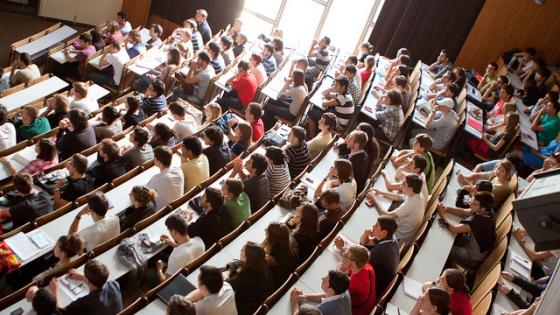Enrolment in tertiary education has increased by a factor of 3.4 in OECD countries since 1970 (UNESCO Statistics 2021) and further expansion figures prominently in political agendas. For example, the EU’s goal for 2030 is that “[t]he share of 25–34 year-olds with tertiary educational attainment should be at least 45%” (Council of the European Union 2021). However, we do not know much about the consequences of such historical and planned expansion processes in terms of the intelligence and socioeconomic background of the students selected into university, even though these consequences are at centre stage in economic models of the allocation of skills (as in the Roy model).
The enlargement of university access enacted in the UK following the 1963 Robbins Report provides an ideal case study to address these issues and to draw policy lessons. In the UK, the share of 17–30 year-olds enrolled in higher education rose from about 5% in 1960 to 43% in 2007 (Chowdry et al. 2013), an increase that mimicked what had already taken place in the US (Goldin and Katz 2008) and would later occur in other OECD countries (Schofer and Meyer 2005, Meyer and Schofer 2007). In a new paper (Ichino et al. 2022), we study the UK experience to evaluate the possible consequences of the ambitious targets for tertiary education currently set in Europe and elsewhere.
The Robbins Report and the intellectual origin of the UK expansion
The intellectual origin of the UK expansion is the Robbins Report (Robbins 1963). In contrast to more recent policy blueprints, this report deserves credit for basing its recommendations on an assessment of what would happen in the future to the skills of university graduates and non-graduates. The report claimed the existence of large “reserves of untapped ability [that] may be greatest in the poorer sections of the community” and recommended that “all young persons qualified by ability and attainment to pursue a full-time course in higher education should have the opportunity to do so”. According to the report, “fears that expansion would lead to a lowering of the average ability of students in higher education [were] unfounded”. These claims have not been adequately investigated, in part because of a lack of data sets containing cognitive-ability measures. Our main data source – Understanding Society: The UK household longitudinal study – allows us to construct a measure of general cognitive ability in addition to predetermined individual measures of socioeconomic and psychological disadvantage (see Ichino et al. 2022 for details).
The consequence of the UK higher education expansion
The top-left panel of Figure 1 shows that our Understanding Society sample reflects the expansion of tertiary education observed in the population: the fraction of graduates increased from about 17% on average in college cohort 1960–1974 to about 32% in college cohort 1990–2004.
Figure 1 Consequences of the UK tertiary education expansion
Notes: A college cohort (university cohort in the UK) is a group of individuals in actual (for graduates) or potential (for non-graduates) college attendance age, labelled by year of birth plus 20 (so, for example, the 1960–74 cohort are subjects born between 1940 and 1954). The fraction of graduates is the share of individuals in a college cohort who have obtained any tertiary qualification (as such, it is slightly different from Chowdry et al. 2013, who consider the population of 17–30 year-olds). An individual’s intelligence is measured by the first principal component of 14 cognitive ability variables (scores in tests of episodic memory, working memory, fluid reasoning, semantic fluency, and problem solving/numeracy, and whether help was received during the test); this measure is normalised to have a mean of 100 and a SD of 15 in each college cohort. An individual’s disadvantage is measured by the first principal component of 13 variables that determine socioeconomic or personality advantage at study (years of schooling of a respondent’s parents, six dummies for whether a respondent’s father or mother were employed when the respondent was 14, whether a respondent was not living with her/his father or mother at age 14, whether a respondent’s father or mother were deceased when the respondent was 14, and the ‘Big 5’ personality traits); the figure shows the average of this measure by graduation status relative to the population in each college cohort. Real hourly wages are expressed in GBP. Data sources: Understanding Society and, for wages, UK LFS.
Our most novel result (top-right panel of Figure 1) is that the average intelligence of university graduates declined by about 13% of a standard deviation between the 1960s and the 1990s. The average intelligence of non-graduates also declined, indicating that students who attained a university degree in the 1990s (and who would have not attained it in the 1960s) were more intelligent than the average high school graduate of the 1960s, but less intelligent than the average university graduate of the same period. As for the socioeconomic status of university graduates (bottom-left panel), this has improved relative to the status of non-graduates, which indicates an increasingly unequal access to tertiary education by family background. Finally, we find that these effects are associated with a decline of the wage gap between university graduates and non-graduates across cohorts (bottom-right panel); Bianchi (2020) has similar results for Italy (Bianchi 2014).
These outcomes for the UK were the result of a non-meritocratic increase in the number of graduates, achieved by reducing non-tuition costs and by lowering qualification barriers at entry into university. Although the “untapped ability” envisioned by Robbins did exist, the higher education policy that eventually prevailed was unfit to draw this ability into universities and ended up favouring primarily low-intelligence children from advantaged families. Our policy simulations, based on a rigorous estimation of model parameters, suggest that only a meritocratic policy based on the selection of intelligent students from any socioeconomic background could have achieved the Robbins Report’s progressive goals. Such a policy would also have been more egalitarian than the policy that was implemented.
Our results do not necessarily suggest that university admission should be made more dependent on test scores of academic performances at the end of high school (for example, A-level grades in the UK). Whether a student has obtained these qualifications and how high he or she scored may reflect selection based on a family’s socioeconomic status occurring earlier in life. This is precisely why in our analysis we define the ‘no college’ group broadly to include any student without a university degree, not only those who left education at the end of high school (sixth form in the UK). It follows that secondary education policies aimed at improving the attainment of talented teenagers from disadvantaged families should support a meritocratic expansion of university. This is also why our analysis emphasises the role of intelligence. We think about a meritocratic policy in terms of low-variance (e.g. repeated over time) and g-loaded intelligence measures that reflect students’ talent independently of their socioeconomic advantage or disadvantage. Proposing such measures is beyond the scope of our analysis (and should be left to experts), but our evidence clearly indicates that this is the way to go if one wishes to increase the number of graduates and their quality while also providing equality of opportunities.
Lower intelligence of university graduates can hardly be characterised as desirable
Although we eschew the difficult question of which social welfare function should be used to determine the decision to expand university access, we claim that lower average intelligence of university graduates can hardly be characterised as a desirable outcome. In our model, higher intelligence is associated (ceteris paribus) with a lower study effort cost, which implies a social welfare gain from a more intelligent graduate workforce relative to a less intelligent one of the same size.
Other reasons may be considered in a richer model. For example, universities have a double role in society: providing higher education but also supporting basic research at an advanced level in all fields, a task that is facilitated by higher cognitive ability. Thus, the consequences of a decline in the average intelligence of graduates are going to be far reaching, particularly if there is reluctance to allow the tertiary education institutions of higher quality to be more selective in their acceptance. The Robbins Report makes clear the lack of a depressing effect on graduates’ average ability as a condition that justifies an expansion. Surprisingly, such a concern is absent in the Council of the European Union (2021), which sets a goal of at least 45% of graduates in the EU by 2030. It is not even clear how this specific threshold has been chosen. Vera-Toscano and Hardeman (2016) raise other related concerns about the opportunity to expand higher education further; the opposite view can be found in Valero and Van-Reenen (2016).
The main driver: A negative correlation between intelligence and disadvantage
Our theoretical interpretation of the evidence indicates that the impact of a policy on average intelligence, social background, and relative earnings of university graduates and non-graduates depends crucially on the correlation between intelligence and socioeconomic disadvantage in the society where the policy is implemented. The reforms advocated by the Robbins Report were motivated by the belief that the UK was a stratified society where access to tertiary education was facilitated more by an advantaged background than by high intelligence. In this society, if the correlation between intelligence and disadvantage is positive, even an indiscriminate or progressive expansion policy may increase the fraction of university graduates without reducing their average intelligence, as the report claimed.
Our evidence suggests that UK society was indeed stratified, but was characterised by a negative correlation between intelligence and disadvantage – a finding with different possible explanations that we discuss in our paper and that we take as given in our evaluation of the tertiary education expansion enacted in the UK. In this context, only a shift towards a strongly meritocratic policy aimed at increasing the graduation probability of students with intelligence above a given threshold (or sufficiently intelligent but disadvantaged) could have achieved the desiderata of the Robbins Report. However, this is not what happened.
Key lesson
Thus, the key lesson that we learn from the UK experience is the following: in the presence of a negative correlation between intelligence and socio-economic disadvantage, which was the case in the UK during the entire period that we consider, a government that wishes to further expand university access without decreasing the average quality of the graduate workforce should be ready to implement the expansion along meritocratic lines. Such a policy does not necessarily exacerbate social inequality: it can actually reduce disparities between equally intelligent students with different backgrounds. While incomplete as a guide towards establishing the optimal university enrolment rate, our conclusions are a step towards an encompassing social welfare analysis that can inform policy decisions.
References
UNESCO Statistics (2021), “School enrollment, tertiary (% gross),” retrieved from World Bank Open Data.
Bianchi, N (2020), “The indirect effect of educational expansions: Evidence from a large enrollment increase in university majors”, Journal of Labor Economics 38(3): 767-804.
Bianchi, N (2014), “Access to higher education and the value of a university degree”, VoxEU.org, 29 December.
Council of the EU (2021), “Council Resolution on a strategic framework for European cooperation in education and training towards the European Education Area and beyond (2021-2030)”, Resolution 2021/C 66/01, Official Journal of the European Union 64.
Chowdry, H, C Crawford, L Dearden, A Goodman and A Vignoles (2013), “Widening participation in higher education: analysis using linked administrative data,” Journal of the Royal Statistical Society: Series A (Statistics in Society) 176: 431–457.
Ichino, A, A Rustichini and G Zanella (2022), “College education, intelligence, and disadvantage: policy lessons from the UK in 1960–2004”, CEPR Discussion Paper 17284.
Institute for Social and Economic Research (2022), “Understanding Society: The UK household longitudinal study”, University of Essex.
Goldin, C and L F Katz (2008), The Race between Education and Technology, Harvard University Press.
Schofer, E and J W Meyer (2005), “The Worldwide Expansion of Higher Education in the Twentieth Century”, American Sociological Review 70: 898–920.
Meyer, J W and E Schofer (2007), “The University in Europe and the World: Twentieth Century Expansion”, in Towards a Multiversity? Universities between Global Trends and National Traditions.
Robbins, L (1963), Higher Education: Report of the Committee Appointed by the Prime Minister Under the Chairmanship of Lord Robbins, 1961–63.
Valero, A and J Van Reenen (2016), “How universities boost economic growth”, VoxEU.org, 10 November.
Vera-Toscano, E and S Hardeman (2016), “Re-thinking the received wisdom on education: alternative policy lessons”, VoxEU.org, 6 January.






